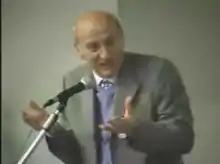Luigi Amoroso
Luigi Amoroso (March 26, 1886 – October 28, 1965) was an Italian neoclassical economist influenced by Vilfredo Pareto. He provided support for and influenced the economic policy during the fascist regime.
Luigi Amoroso | |
|---|---|
 | |
| Born | March 26, 1886 |
| Died | October 28, 1965 (aged 79) |
| Nationality | Italy |
| Field | Microeconomics |
| School or tradition | Neoclassical economics |
| Influences | Vilfredo Pareto |
| Contributions | Amoroso–Robinson relation |
Work
The microeconomical concept of the Amoroso–Robinson relation is named after him (and Joan Robinson): according to paper (Tusset 2000) he is one of the first economists to have studied the dynamical equilibrium theory by using an analogy between economic systems and classical mechanics, thus applying to theories of economical behaviour mathematical tools as the calculus of variation. In his young years he contributed to the theory of functions of several complex variables, giving for the first time a set of necessary and sufficient conditions for the solvability of the Dirichlet problem for holomorphic functions of several variables in the paper (Amoroso 1912).[1] Also, in 1927 he provided to his former Normale schoolfellow Mauro Picone the funding for the creation of the Istituto Nazionale per le Applicazioni del Calcolo, now called Istituto per le Applicazioni del Calcolo "Mauro Picone" by means of a local bank.[2]
Selected works
Mathematics
- Amoroso, Luigi (1912), "Sopra un problema al contorno", Rendiconti del Circolo Matematico di Palermo (in Italian), 33 (1): 75–85, doi:10.1007/BF03015289, JFM 43.0453.03, S2CID 122956910. "On a boundary value problem" (English translation of title) is the first paper where a set of (fairly complicate) necessary and sufficient conditions for the solvability of the Dirichlet problem for holomorphic functions of several variables is given.
See also
Notes
- See also the paper (Fichera 1999, pp. 306–309) for a survey of this problem in his historical context
- See Fichera (1999, p. 307) and Benzi (2005, p. 3) in its preprint version
References
Biographical and general references
- Benzi, Michele (2005), "Gianfranco Cimmino's Contributions to Numerical Mathematics", in Pini, Bruno (ed.), Atti del Seminario di Analisi Matematica, Dipartimento di Matematica dell'Universita' di Bologna. Volume Speciale: Ciclo di Conferenze in Memoria di Gianfranco Cimmino, Marzo-Aprile 2004, Bologna: Tecnoprint, pp. 87–109. The preprint version of the original paper is downloadable from the author's academic web page.
- Fichera, Gaetano (1999), "L'analisi matematica in Italia fra le due guerre" [Mathematical analysis in Italy between the two wars], Atti della Accademia Nazionale dei Lincei, Rendiconti Lincei, Matematica e Applicazioni, IX (in Italian), 10 (4): 279–312.
- Keppler, Jan Horst (1994), "Luigi Amoroso (1886–1965): Mathematical Economist, Italian Corporatist", History of Political Economy, 26 (4): 589–611, doi:10.1215/00182702-26-4-589.
Scientific references
- Tusset, Gianfranco (2000), Habits and expectations in Luigi Amoroso's dynamic equilibrium, Discussion Papers, 14–2000, Department of Economics and Management "Marco Fanno", University of Padua, archived from the original on 2011-05-29, retrieved 2009-05-09